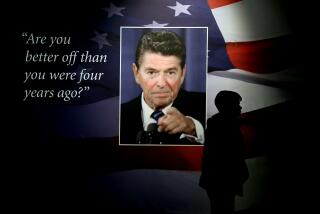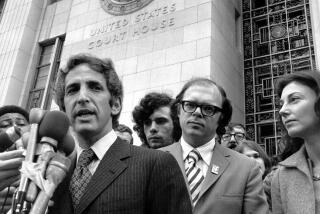Vault in O.C. Holds Trove of Nixon Letters
- Share via
LAGUNA NIGUEL — A little-known treasure lies in a vault here in the pyramid-shaped federal building known as the Ziggurat.
In 418 cubic feet of cardboard boxes that stretch from floor to ceiling, 24,000 folders contain letters chronicling the life of Richard M. Nixon from 1948 to 1964: his attitudes and worries, his relationships, aides, enemies and friends.
The letters, both by and to Nixon, involve such figures as Chiang Kai-Shek, Nikita Khrushchev, Sen. Bob Dole (R-Kan.), Ronald Reagan, baseball great Jackie Robinson, comedian Bud Abbott, television commentator Edward R. Murrow and longtime enemy Alger Hiss.
Some letters talk gravely about nuclear peril; others offer comically serious responses to children asking advice in naming their kittens, which Nixon often did. Others offer insights into the genesis of relationships with such trusted aides as the late H.R. Haldeman.
Those looking for a smoking gun will leave disappointed, says archivist Diane S. Nixon (no relation), who oversees the materials stored in the Chet Holifield Federal Building, which serves as Pacific Southwest headquarters for the National Archives.
Materials related to the Nixon presidency and to Watergate can be found in the National Archives in College Park, Md., or at the Richard Nixon Library & Birthplace in Yorba Linda, Diane Nixon said.
But the regional archive here is the only one in the country to house the private papers of a U.S. President. An emergency plan calls for the papers to be the first thing removed from the building if fire threatens, and during last year’s inferno in Laguna Beach, that plan came within moments of being activated.
The collection is a veritable treasure trove of early memorabilia. Whether it be illuminating letters on Nixon’s feelings about Jimmy Hoffa and Joe McCarthy, or a polite rejection of Walt Disney’s invitation to join the Mickey Mouse Club, the Laguna Niguel archives say much about the local politician who ultimately made good on his boyhood dream of occupying the Oval Office.
Diane Nixon says the former President deeded the materials to the National Archives in 1968 and 1969, the year he was inaugurated. The government transferred the materials to Laguna Niguel in 1978, when Nixon was writing his memoirs at La Casa Pacifica, his estate in San Clemente. They have remained here ever since.
Over the past decade, Diane Nixon said, the Nixon papers, which are available to the public, have drawn one to two visitors a month--scholars, college students, high school teachers and biographers.
The collection is “literally priceless--and the reason this building has such phenomenal security,” Diane Nixon said. In addition to letters, the material consists of campaign files, newspaper clippings and photographs. The only materials excluded from public use are the more than 400 oral history interviews, whose ownership is currently in limbo because of a legal dispute between the National Archives and Whittier College.
The storage also has other memorabilia. One is a turquoise, taffeta dress, embroidered with crystal sequins and worn by the late Pat Nixon while she was First Lady. Another piece is the President’s hulking brown leather chair used in Cabinet meetings.
On display on a table nearby is the letter from Bud Abbott, who congratulated Nixon on winning the 1960 GOP presidential nomination.
“Everyone knows who’s on first,” Abbott wrote.
Another is a reprimand, of sorts, from the man who broke baseball’s color line. Jackie Robinson told the then-vice president in 1960 that African Americans were tired of waiting for racial equality.
“Whenever the President (Eisenhower) is asked about civil rights, he asks the Negro to be patient,” Robinson wrote. “We have been the most patient of any group and cannot afford another four years of waiting.”
Then-entertainer Ronald Reagan wrote Nixon in July of that year, saying that under John F. Kennedy’s “tousled, boyish haircut, it is still old Karl Marx.” Reagan condemned Kennedy’s New Frontier, saying, “There is nothing new in the idea of a government being Big Brother to us all. Hitler called his state socialism. And way before him it was ‘benevolent monarchy.’ ”
The boxes offer snapshots of Nixon, such as the bitterness he conveyed in a letter to current Senate minority leader Dole in January, 1961, days before Kennedy was sworn in as president after one of the narrowest election victories in history.
“As I look back over the 14 years that I have been in Washington, I recall times when the pressure of constituents seemed unbearable,” Nixon wrote. “And when people for whom I and members of my staff had done a great deal seemed unreasonable and ungrateful. There will be occasions when you will be discouraged and literally ‘fed up’ with Washington.”
Several letters appear from former Tennessee Sen. Howard Baker, who closed his missives to Nixon throughout the 1960s by wishing him “happiness and success in the future.” Ironically, it was Baker who played a pivotal role in Nixon’s future as a member of the Senate committee that investigated Watergate, which led to the call for Nixon’s impeachment and his resignation in 1974.
The cultivation of his relationship with eventual Secretary of State Henry A. Kissinger, then a professor at Harvard, is evident in a rare series of letters. Kissinger, clearly a man whom Nixon respected, was the object of numerous and effusive compliments from the then-vice president, whom Kissinger later served as the architect of detente with the Soviet Union and China.
The material also includes the whimsical. In March, 1961, Nixon informed an upstate New York woman that he had referred the matter of naming her daughter’s kitten to his own daughters, Tricia and Julie.
“And they came up with the suggestion of Puff as both a favorite name and kitten of theirs,” he wrote.
Months before, Nixon had given a kitten to a 6-year-old Seattle girl, who named it Milhous, the president’s middle name. Other information in the “Kittens” folder includes instructions for picking up cats at airports, and polite letters informing constituents who had requested one that he had no more kittens left to give.
Much of the material details the tediousness of public life--seemingly heartfelt letters to emotional constituents, obligatory thank-you’s, intricate files on friends and foes. The letters also chronicle the obscurity and thanklessness of simply being vice president.
In August, 1956, for instance, then-Vice President Nixon wrote Walt Disney of his disappointment in not being available for an interview by “one of the young reporters from ‘The Mickey Mouse Show’ so that I might answer the question: ‘When I Grow Up, Mr. Nixon, Why Should I Be a Republican?’ ”
The letters also reveal what critics have called Nixon’s “shadow” side, his tendency toward suspicion and even paranoia and how aides instinctively picked up cues from the boss. In one memo, Nixon’s secretary, Rose Mary Woods, bitterly refers to his longtime adversary, Alger Hiss, as “Alger the Hiss.”
In one letter written on behalf of Nixon, H.R. Haldeman angrily rebukes the editors of Life magazine for publishing a photograph of Nixon in 1963 taken after his defeat in the California gubernatorial election the year before.
“The full-page picture of Nixon plodding his way through the palm trees makes him look like a pathetic, lonely figure,” Haldeman wrote, “and as you will recall in the magazine it was faced by a bright cheery picture of (incumbent) Pat Brown and his wife bouncing out of the governor’s mansion. I still can’t believe that this picture editing was an accident.”
At the end of one such diatribe, Haldeman penned a handwritten note at the bottom of the letter he had mailed to Life, a copy of which he sent to Nixon: “Good for another chuckle anyway--H.”
The Laguna Niguel archives chronicle in detail the full flowering of the Haldeman-Nixon relationship, revealing in the young Southern California advertising executive from the J. Walter Thompson Co. a loyalty so unwavering that it ultimately landed him in prison for offenses committed during Watergate.
More to Read
Sign up for Essential California
The most important California stories and recommendations in your inbox every morning.
You may occasionally receive promotional content from the Los Angeles Times.










